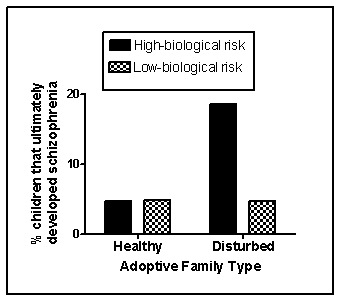Scenario II
The following scenario presents fabricated data consistent with the results of the following study:
Tienari, P., Wynne, L. C., Sorri, A., Lahti, I., Läksy, K., Moring, J., & ... Wahlberg, K. (2004) . Genotype-environment interaction in schizophrenia-spectrum disorder: Long-term follow-up study of Finnish adoptees. The British Journal of Psychiatry, 184(3) , 216-222. doi:10.1192/bjp.184.3.216
Schizophrenia affects approximately 1 percent of the general population and is characterized by the profound disruption of basic psychological processes; a distorted perception of reality;, altered or blunted emotional affect; and disturbances in thought, motivation, and behavior. The symptoms of schizophrenia are varied and are typically classified as either positive or negative. Positive symptoms of schizophrenia refer to thoughts and behaviors typically not observed in those without the disease, and can include things like delusions (patently false beliefs) , hallucinations (false perceptual experiences) , and disorganized speech. Negative symptoms of schizophrenia are deficits or disruptions in normal behaviors, such as social withdrawal. Cognitive deficits in executive functioning, attention span, and working memory also may be observed.
The symptoms of schizophrenia usually begin in late adolescence and the disease has a strong genetic component. Over the years, a number of biological factors have been linked to schizophrenia, although none alone adequately accounts for the disorder. One such example is the dopamine hypothesis, which states that schizophrenia is related to an excess in dopamine activity. Another theory points to enlarged brain ventricles and progressive cortex tissue loss as predictive of schizophrenia, although only a minority of persons with schizophrenia have enlarged ventricles, this structural anomaly can appear in those without the disease, and dopamine antagonists also may produce this effect.
Although research into the environmental determinants of schizophrenia has focused largely on the prenatal environment, psychological and social factors also contribute. Tienari et al. (2004) compared the risk of developing schizophrenia in children adopted into healthy versus disturbed families, the latter characterized by extreme conflict, volatile relationships, and communication deficits. Some of these children under investigation were identified as at-risk genetically for schizophrenia because their biological mothers were schizophrenic. The remainder was classified at low risk. The investigators utilized a longitudinal design and obtained the diagnostic status of the children with respect to schizophrenia when they reached young adulthood. Fabricated results consistent with this study are shown in Figure 15.2
Figure 15.2 
-(Scenario II) The dopamine hypothesis of schizophrenia was developed in large part due to research on the effects of psychoactive drugs in the brain. Research supports all of these statements EXCEPT:
Definitions:
Muscular Tubes
Structures composed of smooth muscle, designed to transport substances through contractions, found in organs like the intestines and blood vessels.
Hernia
A condition in which part of an organ is displaced and protrudes through the wall of the cavity containing it, often creating a bulge.
Renal Artery
A blood vessel that carries oxygenated blood to the kidneys.
Bacteriologic Culture
The laboratory process of growing bacteria from a sample to identify a possible infection.
Q2: Explain what is meant by biofeedback therapy.
Q8: Overactivity of the caudate nucleus is the
Q9: Discuss the two types of antipsychotic medications,
Q14: Which of these is MOST likely to
Q14: In obsessive-compulsive disorder, the obsessive thoughts typically
Q22: The cognitive strategy for managing stress that
Q28: Directing attention toward the body _ the
Q70: The release of estrogen triggers a tend-and-befriend
Q71: A psychologist usually cannot prescribe medication.
Q121: A person in an episode of mania